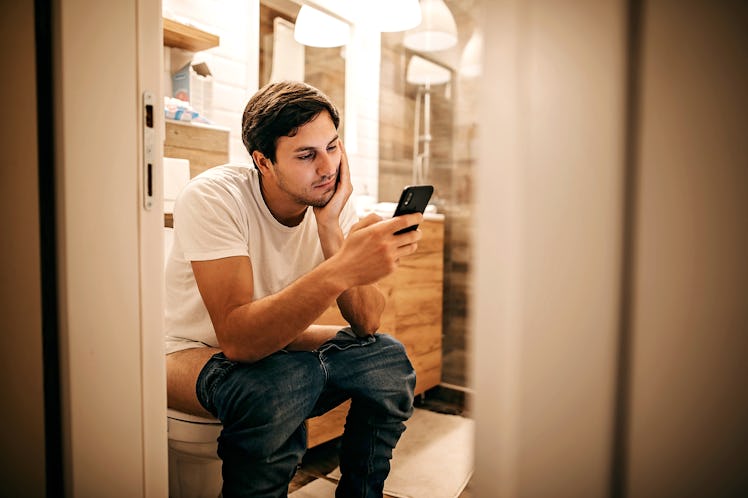Is Sitting On A Toilet For Too Long Bad For Your Health?
Hanging out on the toilet is cool, as long as it’s not all sweating and pushing.

A dad’s compulsion to linger on the toilet after a poop is strong. After all, the room is private, locked, quiet, and the fantasy league, social feed, and daily news are glowing at the fingertips. Now, for those that tend to dally in the throne room, there’s good news — while your wife is banging on the door, going on about hemorrhoids or whatever, you can sit confident. Because we called a top gastroenterologist and he says that as long as you’re not straining when you sit on the toilet for hours on end, you’re fine.
Satish S.C. Rao, M.D., Ph.D., director of neurogastroenterology and motility at the Medical College of Georgia at Augusta University, was unequivocal. So, is there any medical issue with the way the buttocks interacts with the toilet seat that could somehow cause trauma to the anus? “None whatsoever,” he says.
“If you’re just going to sit there, and it’s a good time for you to catch up on gossip and news, I don’t think that, per se, is harmful,” he explains, as long as a person has enough padding on their butt and can tolerate the rigid seat. “Just sitting is not harmful. It’s the effort and straining for long periods of time — that is where the harm comes.”
If there’s any danger between man and toilet, Rao stresses, it’s in the strain. The problem with excessive straining during defecation is that, over time, it weakens the nerves and muscles of the pelvic floor.
“In the pelvic floor area, the nerves actually intertwine with the muscle,” Rao says. “When you have that kind of arrangement and excessively move the muscle repeatedly, then the nerve is subjected to repeated nerve trauma.” That can lead to a prolapsed rectum and even leakage of stools, he says — not the sort of thing that finishing a New Yorker article before flushing can justify.
It’s important, then, to understand what excessive straining actually means. Rao says that a normal bowel movement should start with an urge to poop (good so far), followed by an average of five minutes of defecation with little straining. Problems begin occurring once a person has been straining for 10 minutes or longer.
Straining has some pretty serious, hair-raising drawbacks. We’ll pause here to warn those with a weak constitution that what follows is pretty awful, so skipping the next paragraph may be advised.
One of the worst-case scenarios from excessive straining is called internal rectal prolapse, Rao says. This is a condition in which the lining of the rectum actually comes out through the anus. And because the lower two inches of the rectal lining are incredibly sensitive, touching it can give you constant feeling of urgency, resulting in more straining. “You’re trying to poop your own lining,” Rao says. And eventually it does come out.
Luckily, this is an extreme scenario that can be avoided by recognizing when the strain has gone on too long. That’s 10 minutes. Set the timer.
Rao adds that modern toilets don’t help matters much. “Unfortunately, the way we poop now in the modern age is not optimally designed for pooping,” he says. “We are optimally designed to poop in the squatting position.” Because of this, he has high praise for devices like the Squatty Potty, which are designed for a more ergonomic pooping experience. Not that he isn’t a bit jealous of the Squatty Potty’s breakout success (Rao has been offering his patients a nearly identical low stool that positions the body in a perfect squat for 20 years). “I should have millions,” he jokes.
This article was originally published on